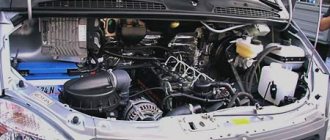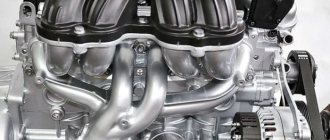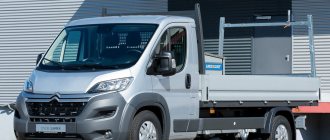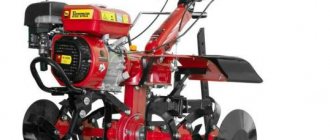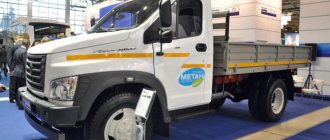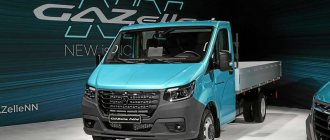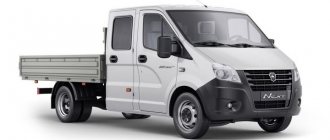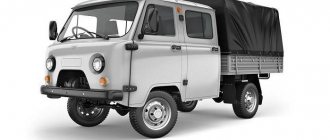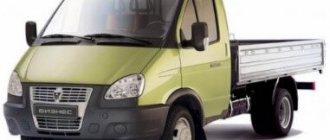In Russia, they are accustomed to constantly modernizing power units manufactured back in the Soviet years, and the Evotek engine also went through this. In fact, the basis of this engine is the Volgovsky Gas M 21. It was created back in 1956 and has only undergone changes since then. But despite the modernization, the distances between the cylinders remain the same, the diameters of the connecting rod journals are the same, the camshafts and crankshafts are no different from each other. The modernized engine is installed on vehicles for commercial transportation: Gazelle Next, Raf.
Negative reviews
My wife and I, too, after the purchase, satisfied, loaded the kitchen with 500 kg, drive 100 km from Moscow, we got there, 3rd and 4th gear, ate, ate, but you can completely forget about the fifth, it doesn’t even pull downhill. Read reviews before purchasing, don't do it like us.
The car starts to break down at 2000 km. At 3800 km the clutch burned out. The service guy said I burned it with a specialist. An invoice was issued for RUR 16,000. I think it's suing.
Advantages:
- No
- I took my first gazelle back in the spring of 1995. It cost exactly $4,000 in Nizhny Novgorod. Compare now.
- No reliability
- I know a lot of people who bought it and got rid of it as soon as possible.
I don't recommend buying. It seems to me that before they were more reliable, poorer, but more reliable. In a year and a half, two Gazelles burned out: Next and a business with the evotech engine. Check your insurance to see if there is a clause regarding a short circuit in an electrical circuit. CASCO does not help, the factory and the seller wash their hands. I've been using the first one for over a year. Sometimes they lose documents, sometimes not everyone comes. The second one burned down two weeks ago. I'm waiting for the conclusion of the Ministry of Emergency Situations. But on site both times they said there was a short circuit. Although I rented a diesel engine, it worked with the usual breakdowns. transmission repair at 120,000 km.
I bought Next with petrol and went through five thousand at the beginning I was eating 19-20 now 14 liters 95th on 92nd doesn’t go uphill like on a horse-drawn cart from the mountain nothing if there was no wind in one word the sheep invented felt boots no more wonders about the cabin I agree it’s cheerful and that’s it the rest completely sucks, you don’t need to invent anything, have you finalized the business and 405 and that’s enough in one word: chumvtarydsmile
It's a shame and not the car that antifreeze got into the combustion system at 9000 tons of kilometers and what do you think 40,000 tons of rubles it all came out and we waited for the spare part for a month, it sucked Evotek was 405 I didn’t know grief
For passengers, it’s hell, there’s almost no space between the seats, the knees rest against a slight bump or hole, it’s already jumping up and down, there’s no noise, the seats are hard, they were better on the old gazelles.
Reviews from real owners of the new Gazelle Next 2013-2014
Yuri33:
07/07/2014 at 17:26
I bought a new Next at the end of May 2014. Now the mileage is 7912 km. So far there have been no problems. I’ll say right away that after reading about problems with injectors, I installed an additional Mana filter when purchasing. Next I bought from the database for 764 rubles with a tilt body. I didn’t intend to overload, but just in case I threw a sheet on each spring. I drove it home, assembled the awning, waxed the frame and body, hung a chain on the spare wheel with a lock, welded the original crap onto the neck of the fuel tank so that the fuel would not be drained. Well, what can I say about exploitation? The engine is a bit dull when accelerating, but it pulls normally. I only fill up with fuel using Lukoil. I decided to change the oil in the engine at 7900 mileage because it had turned completely black. Many people change at 2000 for the first time, but I didn’t. Why am I thinking about changing it if it still looks normal? I changed it myself, no problems at all. The filter is inexpensive, and the oil was Rimula semi-synthetic 20 liters for 4,400 rubles. It took me a long time to find the key for the drain plug. There is no such thing in stores, there is no such thing in warehouses, in short, I bought a similar one and modified it with sandpaper. I also looked at the air filter and replaced it too. I wanted to change the fuel at the same time, but I didn’t. I unscrewed the lid of the separator, pulled out the filter, and it was like new and sterile in the separator at the bottom, that’s what a good, proven refill and an additional filter mean. I put everything in place and I think for now I’ll go to 15 thousand, and then I’ll change it. I did not change the oil in the axle and gearbox. The factory says not to change until 60 thousand. I think by winter, if I drive so much, maybe I’ll change it to imported oil. Overall I'm happy with the car. The expense is not high. I don’t give her more than 80 and the consumption is within the top ten. There is no point in igniting it since the consumption is greater and, accordingly, there is less clean money left. I installed the tape recorder myself. I bought it for 2 thousand, cut a hole for it, all the chips are there, stuck it in and everything is ok. Now we have flash drives and disks and a radio, and everything works, not like with the original radio, which is always glitchy. There have been no problems so far. But our auto industry, no matter what you call it, will remain ours. Here's an example: When the car heats up in the sun, when you open the driver's door it starts to catch on the fender; a couple of times I just couldn't open it and got out through the passenger door. It opens at night without problems and doesn’t get stuck. The rubber band on the driver's side wiper periodically came out of the rocker arms and they began to scrape the glass, so I had to finish everything myself. The door seals are flimsy. The nephew began to get out of the car, stepped on it and it tore, and at the top they are still peeling off. The lids in the thresholds that cover the tool boxes are flimsy and do not hold well. One time the dashboard simply turned off while driving, turned off the engine, started it, everything worked. Once the tidy just glitched (the mileage dropped somewhere), it helped again after plugging and starting. And so, if such little things are eliminated, then we can say that the car is no worse than an imported one. I’m just surprised that it’s really not possible to do all this normally at the factory, what kind of freaks. It doesn’t seem like anything is breaking, but damn it, sometimes it comes unglued, sometimes it won’t close, sometimes it gets stuck. And such seemingly trifles, but the mood spoils.
Answer
Neutral reviews
Advantages:
- Front suspension
- salon
- cost of maintenance.
- Cabin build quality
- electrician
- car dimensions.
But in general it’s not bad, like any car you need to take care of it and then it will serve you faithfully for a very long time. As for the body, it’s not bad that they started installing plastic fenders that never burn out. BUT. Why not calculate the gap between the fender and the door so that when opening the door does not cling to the fender and break it. No other particularly major deficiencies were noticed. As for the quality of electrics, there are also many questions. The rear wiring of carburetor gazelles that have traveled more than 500 thousand kilometers looks better than the wiring of the Next that passed through one winter. It’s very cool when there is a factory central lock and power windows, but it’s not very good when the wiring to them at the entrance to the door is redone after just half a year of using the car. Sweating fog lights, poor contact on power fuses, non-sealed taillights and many more questions about the build quality of the electrics. In terms of comfort for the driver, Next is many times superior to its predecessor, due to the front suspension in which they got rid of the beam, interior and exterior of the cabin.
As a resident of St. Petersburg, I encountered such a problem - Next does not fit into the arches in the courtyards in the center, in this case Business wins.
The engine and chassis will not cause any special problems if you maintain it on time, operate it carefully and pamper your car with original spare parts and consumables.
Thanks to everyone who read the review to the end. I hope it will be useful to you.
The car is great. Yes, of course, it doesn’t happen every once in a while, there are breakdowns, spare parts are made at different factories, and sometimes there are defects. But here we must pay tribute to GAZ. Despite the fact that the spare parts they buy are not cheap and of high quality, they do not break the prices for their products. Of course, in some places it is necessary to reduce the cost of the car, but this is done entirely in non-critical and non-vital components.
149 horses is enough, I don’t feel like it’s being stifled. In comparison with my previous gazelle with the same fireplace. The car doesn’t feel the load at all, even if it’s empty, even if it’s two tons, it moves the same way.
Positive reviews
I bought it a year ago from the officials of Next, fully equipped, with the installation of a refrigerator. The car is made of very high quality, I went through everything properly before purchasing, I didn’t find any serious flaws, just minor flaws, mostly gaps. Over the course of a year, the car traveled 134 thousand km, rested little, almost every day on the road, there were no serious breakdowns, of the unscheduled replacements, only the shock absorber strut on the left side leaked (the driver looked at the pit), the rest was changed as part of the maintenance. I really liked how the Next behaves on the road, the car is tall and heavy, like a ship on the waves. The suspension handles road unevenness perfectly, a lot of leverage solves it.
I have a NEXT with Evotech, I took it because I’m used to gasoline engines, I understand at least a little about gasoline engines, the mileage is currently 240 thousand km, the engine is without capital, only replacement of consumables and minor repairs, the engine runs smoothly, without vibrations, noise and there are no knocks, the pickup from the bottom is good. When taxiing, the reactions are clear, it responds well to steering turns, it’s smooth on the runway, it’s not fidgety, the suspension is tight and moderately soft.
Evotech engine: characteristics, reviews
- New Evotech 3.0 engine for GAZelle NEXT
- It's better now, but...
- Expected better
- Gazelle Next is a step forward from Gazelle Business.
- Not bad, not bad
- Not a bad car at all
- Before you criticize, you need to drive 100-200 thousand.
- Below the average
- Not a bad Russian-assembled car
- Horror on wheels.
- Not a bad car
- Bad car
- For that kind of money it could be better
- The car is AWESOME
- Excellent new generation of gazelles
- GAZ presented the GAZelle Next with a 3.0-liter four-cylinder engine
The Gorky Automobile Plant has developed a new modification of the GAZelle Next light commercial vehicle with a bi-fuel engine capable of consuming both gasoline and compressed natural gas (methane). The machine is equipped with a modernized four-cylinder UMZ Evotech engine with a displacement of 3.0 liters. The regular Evotech version has a volume of 2.7 liters.
Increasing the working volume of the power unit to 3.0 liters made it possible to increase power to 120 hp. when driving on gasoline (when driving on methane - 109 hp), and the maximum torque is up to 252 Nm (225 Nm when driving on methane).
The Evotech 3.0 uses a cast iron cylinder block instead of the aluminum one installed on previous versions. This made it possible to reduce the heat load and increase the stability of the power unit at high temperatures. Changes also affected other components, including the crankshaft and camshaft, cylinder head and piston. The new design allows for the installation of a dual-circuit air conditioning system for minibuses and two compressors for refrigerated vans.
Four gas cylinders are installed on the vehicle with a total volume of 33.2 (all-metal van) to 41.6 (on-board modifications) cubic meters. m. The car's power reserve is up to 750 km, including 300 km on gas. Gas cylinder equipment manufactured by the Italian companies Emer and OMVL is certified according to UNECE Regulations No. 110. The multi-level engine safety system includes a high-speed valve (limit gas leakage in case of damage to gas tubes), a “fire valve” (ensures gas release when the temperature exceeds 100°C ), safety valve (provides gas release when the pressure exceeds 300 atm.).
As the GAZ press service notes, the use of methane reduces operating costs by 40-50% compared to gasoline and diesel fuel. In addition, the methane-consuming vehicle has low emissions.
When the methane GAZelle Next will go into production and how much it will cost is not specified.
Let us remind you that the model is now equipped with gasoline engines UMZ Evotech (2.7 l, 107 hp), diesel engines Cummins ISF (2.8 l, 149 hp), as well as bi-fuel UMZ Evotech 2.7 (consumes gasoline and butane- propane). In September, GAZ presented the modernized GAZelle Next - with a Volkswagen turbodiesel (2.0 l, 136 hp) and a 6-speed manual transmission.
GAZelle Next Evotec acceleration on propane gas
Evotech Specifications
The Evotech engine has the following technical characteristics, which you will see in the table below.
| Parameter | Meaning |
| Configuration | L-shaped |
| Cylinders | 4 pieces |
| Engine capacity | 2.7 l |
| Type | Petrol |
| Cylinder diameter | 96,5 |
| Piston stroke | 92 |
| Compression | 10 |
| timing belt | OHV |
| Power | 106 horses |
| Torque | 225 Nm |
| Nutrition | Distributed injection |
| Ecoclass | Euro 4 |
| Weight | 177 kg |
Attention! Experienced mechanics say that the engine efficiency is 90 percent. This engine was created for Gazelle business, Next and other small trucks.
The creator of the engine is UMZ - Ulyanovsk Machine-Building Plant. As an update, the Evotek engine received components and parts from leading companies producing motors for vehicles.
The service life of the Evotek engine is 400,000 kilometers according to the manufacturer. Those who have already driven this engine are satisfied with the assembly and the parts that are in it from the factory. Unlike its counterparts that were produced in the 2000s, this engine consumes almost no oil and has a high environmental class.
Experienced car owners notice that torque has increased across wide rpm ranges. Even fuel consumption has decreased compared to the previous generation power units from the Ulyanovsk plant. Now the engine consumes 10 percent less fuel.
Similar article Design and repair of a Cummins engine for a Gazelle
In addition to the improvements described, the Evotek engine has now become a hybrid. It can run on either gasoline or gas. Let's look at its other design features.
New Evotech 3.0 engine for GAZelle NEXT
It's better now, but...
Expected better
Gazelle Next is a step forward from Gazelle Business.
Not bad, not bad
Not a bad car at all
Before you criticize, you need to drive 100-200 thousand.
Below the average
Not a bad Russian-assembled car
Horror on wheels.
Not a bad car
Bad car
For that kind of money it could be better
The car is AWESOME
Excellent new generation of gazelles
Upgraded Evotech 2.7 engine
History of the creation of Evotech 2.7
At the beginning of the second decade of the 21st century, the engineers of the GAZ company were faced with a serious question. It was necessary, in a short time, to create a new, powerful, economical engine for light-duty trucks that meets European environmental safety requirements. This task arose due to the great popularity and demand for ZMZ brand gasoline engines for Gazelles. The Ulyanovsk plant planned to produce not something similar, but much better and more economical.
All these requirements presented a complex and time-consuming task. In addition, the deadlines for its implementation were extremely tight. Therefore, the right decision was made to seek help from the South Korean engineering corporation Tenergy. This company had extensive experience in scientific research and design activities.
The joint design team did a great job, more than 25 different power units were reviewed and tested. And in the end, they didn’t come up with anything better than using the UMZ 4216 engine as a basis.
Based on UMP 4216...
What kind of miracle of technology is this that they decided to create a super modern engine on its basis? UMZ 4216 belongs to the family of 421 engines from the Ulyanovsk plant, which was created on the basis of the internal combustion engine of the Zavolzhsky plant ZMZ 402. The 402nd was a successful engine for its time. But we must not forget that instead of the rear crankshaft oil seal, an oiled rope was used, which could not withstand a load of more than 2500 rpm. In addition, the 402nd is a slightly modified engine of the 50s GAZ M 21 Volga.
Undoubtedly, over a long period of operation, the engines were modernized several times; the rope seal packing at the rear end of the crankshaft was replaced with a normal seal on the UMZ 4216. But the inter-cylinder distances of the block remained unchanged, the connecting rod and main journals did not change, they are the same diameter as on the GAZ 21.
The connecting rods remain the same, and the cylinder block cannot be confused with another engine outwardly.
However, other components of the power unit have changed their appearance beyond recognition.
The main changes include:
- to obtain an economical engine, the cylinder volume was reduced by 200 cm3, now it was 2.7 liters;
- The exhaust has undergone major changes; it now ensures compliance with environmentally friendly requirements of Euro 4 and Euro 5.
There were many other, less significant changes, which will be discussed below. At the end of 2013, the first prototypes of Evotech 2.7 were created, they performed well in bench and laboratory tests. And already 2014 became the year of release of the first production Evotech 2.7 engines.
GAZ presented the GAZelle Next with a 3.0-liter four-cylinder engine
The car starts to break down at 2000 km. At 3800 km the clutch burned out. The service guy said I burned it with a specialist. An invoice was issued for RUR 16,000. I think it's suing.
Advantages:
- No
- I took my first gazelle back in the spring of 1995. It cost exactly $4,000 in Nizhny Novgorod. Compare now.
- No reliability
- I know a lot of people who bought it and got rid of it as soon as possible.
I don't recommend buying. It seems to me that before they were more reliable, poorer, but more reliable. In a year and a half, two Gazelles burned out: Next and a business with the evotech engine. Check your insurance to see if there is a clause regarding a short circuit in an electrical circuit. CASCO does not help, the factory and the seller wash their hands. I've been using the first one for over a year. Sometimes they lose documents, sometimes not everyone comes... The second one burned down two weeks ago. I'm waiting for the conclusion of the Ministry of Emergency Situations. But on site both times they said there was a short circuit. Although I rented a diesel engine, it worked with the usual breakdowns... gearbox repair at 120,000 km...
I bought Next with petrol and went through five thousand at the beginning I was eating 19-20 now 14 liters 95th on 92nd doesn’t go uphill like on a horse-drawn cart from the mountain nothing if there was no wind in one word the sheep invented felt boots no more wonders about the cabin I agree it’s cheerful and that’s it the rest completely sucks, you don’t need to invent anything, have you finalized the business and 405 and that’s enough in one word: chumvtarydsmile
It's a shame and not the car that antifreeze got into the combustion system at 9000 tons of kilometers and what do you think 40,000 tons of rubles it all came out and we waited for the spare part for a month, it sucked Evotek was 405 I didn’t know grief
For passengers, it’s hell, there’s almost no space between the seats, the knees rest against a slight bump or hole, it’s already jumping up and down, there’s no noise, the seats are hard, they were better on the old gazelles.
Advantages:
- Front suspension
- salon
- cost of maintenance.
- Cabin build quality
- electrician
- car dimensions.
But in general it’s not bad, like any car you need to take care of it and then it will serve you faithfully for a very long time. As for the body, it’s not bad that they started installing plastic fenders that never burn out. BUT. Why not calculate the gap between the fender and the door so that when opening the door does not cling to the fender and break it. No other particularly major deficiencies were noticed. As for the quality of electrics, there are also many questions. The rear wiring of carburetor gazelles that have traveled more than 500 thousand kilometers looks better than the wiring of the Next that passed through one winter. It’s very cool when there is a factory central lock and power windows, but it’s not very good when the wiring to them at the entrance to the door is redone after just half a year of using the car. Sweating fog lights, poor contact on power fuses, non-sealed taillights and many more questions about the build quality of the electrics. In terms of comfort for the driver, Next is many times superior to its predecessor, due to the front suspension in which they got rid of the beam, interior and exterior of the cabin.
As a resident of St. Petersburg, I encountered the following problem - Next does not fit into the arches in the courtyards in the center, in this case Business wins.
The engine and chassis will not cause any special problems if you maintain it on time, operate it carefully and pamper your car with original spare parts and consumables.
Thanks to everyone who read the review to the end. I hope it will be useful to you.
The car is great. Yes, of course, it doesn’t happen every once in a while, there are breakdowns, spare parts are made at different factories, and sometimes there are defects. But here we must pay tribute to GAZ. Despite the fact that the spare parts they buy are not cheap and of high quality, they do not break the prices for their products. Of course, in some places it is necessary to reduce the cost of the car, but this is done entirely in non-critical and non-vital components.
149 horses is enough, I don’t feel like it’s being stifled. In comparison with my previous gazelle with the same fireplace. The car doesn’t feel the load at all, even if it’s empty, even if it’s two tons, it moves the same way.
I have a NEXT with Evotech, I took it because I’m used to gasoline engines, I understand at least a little about gasoline engines, the mileage is currently 240 thousand km, the engine is without capital, only replacement of consumables and minor repairs, the engine runs smoothly, without vibrations, noise and there are no knocks, the pickup from the bottom is good. When taxiing, the reactions are clear, it responds well to steering turns, it’s smooth on the runway, it’s not fidgety, the suspension is tight and moderately soft.
Next's diesel engines are beyond praise, good traction and adequate fuel consumption, I worked on this for some time, everything in the car was thought out, down to the smallest detail. The car has reached a completely new level in comparison with previous models. In terms of reliability, Next is pleasing, the car turned out to be of high quality, it doesn’t make brains, and it doesn’t let you down at the right time.
Gazelle Next board, awning, purchased in 15, motor kamins, purchased on lease from a dealer in Minsk. Currently the mileage is 211 thousand km. For 3 years it hasn’t caused any problems, I work on the car every day, the mileage in the region is long. The dealer fully respected the warranty, there were never any disputes, everything was fixed as needed and on time, in this regard it’s really nice. I like the car when I work, and after that the business is much more pleasant and comfortable.
Design Features
The engine cylinder block of the A271 Evotech model is made of cast iron. Previous engines were all made with an aluminum cylinder block. This affected the short life of the motors. They were sensitive to overheating. And often the cylinder block was simply deformed.
Evotek with a cast iron cylinder block showed its best side. A new camshaft was also introduced. This introduction increased the engine speed and increased the power of the power unit. The valve timing, sealing connections, mounting components, and cooling system were changed. Changing the latter increased the life of the Evotek a275 engine. The new design of the cooling jacket increased the engine's ability to operate under severe operating conditions. Now he is no longer afraid of overheating.
The gas distribution mechanism was also installed of a new type. It was driven by a chain. Special camshafts were manufactured by a Korean company for this engine. The fists on them had a special sharp shape. This shape increased engine power, but reduced torque.
The timing belt was still of a simple design, although the cylinder head was also modernized. It was made of aluminum. Frequent overheating led to deformation of the cylinder head, or the rubber gasket burned out.
Hydraulic compensators were installed. Now the car owner did not need to constantly visit the service center to correct the thermal valve clearances. Everything was done automatically, inside the engine.
However, the disadvantage of the design was the extremely frequent use of plastic parts in the motor components. Although manufacturers managed to reduce the weight of the engine, plastic parts became the reason for frequent visits to the service center by car owners.
The piston group and spark plugs were developed by LG from South Korea. The electronic control system sensors were created by Bosch from Germany. And the hydraulic compensators were manufactured by the American company Eaton.
Similar article 1AZFE engine: resource, characteristics and problems
Manufacturers say that they managed to reduce the load on the components and parts of the piston group of the Evotek engine, and improve the recirculation of exhaust and crankcase gases. This optimization was made possible thanks to the use of high-quality imported components.
The manufacturer says that the Evotek engine is subject to major overhaul. It is possible to bore the cylinders in the block, since it is cast iron. The remaining spare parts are repairable. For example, the crankshaft and camshaft of some car owners were subject to three repairs and after that another 100 thousand kilometers were required.
In principle, everything turned out the way the Evotek engine manufacturers intended. Fuel consumption was reduced, power was increased at low speeds, which played into the hands of car owners of small-sized trucks.
In addition, the manufacturer has not raised the price of the new Evotek engine, which costs the same as other engines that were manufactured before 2012.
Let's now look at the reviews left by buyers of cars with this Evotek engine. It must be said that there are negative reviews due to problems with the engine that arose during the first tens of thousands of kilometers.
Gazelle Next with Evotech petrol engine
One of the domestic car models is the Gazelle Next with a gasoline engine, which absorbs all the positive qualities of its predecessors and is complemented by domestic innovations. The modern automobile market is becoming more extensive and diverse every year. Just look at the new Mercedes or Toyota models, which embody all the best that has been invented in the industry in recent years.
Evotech engine installed on gazelle Next
Updated Gazelle Next
Gazelle Next entered the domestic market not so long ago, but has already managed to conquer many people with its high practicality, efficiency and external characteristics. At the same time, if the visual appeal of the car is entirely the merit of the design workshop, then its technical characteristics are due to some changes in the mechanical part.
The main difference of this model is the evotech 2.7 petrol engine, which is installed only in the new line of GAZ cars.
Gazelle-Next: gasoline or diesel?
There are constant disputes between motorists. Which body is better, do you need supercharging, rear-wheel drive or front-wheel drive, automatic or manual, springs or springs... Here's another burning question - gasoline or diesel? The domestic bestseller of the LCV market Gazelle-Next offers both options: petrol Evotech 2.7l and diesel Cummins 2.8l. Owners of GAZ cars have written hundreds of forum pages in attempts to find out the truth.
Why is the Evotech engine better?
Evotek is cheaper. The difference in price between gasoline and diesel Gazelle-Next for August 2022 is 160 thousand rubles. This is 17% of the cost of the car. When businesses purchase cars, these thousands can easily add up to millions. And private carriers often have no choice - the budget is very limited, and they want to pay less on the loan. Gazelle will quickly recoup the investment and begin to make a profit.
Evotech will not be a revelation for Russian car services. This is the UMZ-4216, which is familiar to them. There are minimal external differences, only a plastic cylinder head cover and a receiver. In fact, almost all parts were redesigned or replaced with imported ones. But in general, the design has not changed, which means that any mechanic can still determine the cause of the malfunction “with his eyes closed.” Finding spare parts is not difficult.
Evotech 2.7 petrol engine on the stand
Power and torque also remained unchanged: 107 hp. With. and 220 Nm respectively. But peak torque now occurs at lower rpm, 2350 instead of 2500. This means that the engine produces maximum thrust faster. Here we come to one of the main advantages of the Evotek: it is a real “truck” engine. Many carriers miss ZMZ engines, but Trans-Volga engines reach their 220 Nm only at 3900 RPM - a figure typical for a passenger car. And the design of the gas distribution mechanism with rods and rocker arms instead of chains is only beneficial here: reliability in commercial vehicles is more important than the ability to reach high speeds. Yes, Evotek will lose in traction to a diesel engine, but it pulls its rated load capacity of 1.5 tons honestly. If the Gazelle does not work with overloads, transports passengers, personal belongings, agricultural implements, tools or equipment, a gasoline engine is what the doctor ordered.
Evotech is produced in the EURO-5 modification; compliance with these standards was taken into account during development. This is a good foundation for the future. Sooner or later these norms will be adopted in Russia. Let us remind you that EURO-6 standards are already in force in Europe; cars of a lower class are not sold there. The Cummins diesel engine complies with EURO 4, and increasing the environmental class will require serious modifications.
The last argument is factory models with gas equipment. For many carriers it is also decisive. This version is 56 thousand rubles more expensive. Savings on fuel compensate for this amount after 24 thousand kilometers. And then - 2,300 rubles of net benefit for every thousand kilometers.
Main advantages of diesel
Every tenth diesel engine produced in the world bears the Cummins name. They are used wherever a diesel engine can be used: ships, power plants, mining equipment and, of course, cars. The American company gained popularity in the 20s of the last century with its electricity generators for farms. The diesel engines in these generators could operate without stopping for several years without breaking down. Since then and to this day, the word Cummins has been synonymous with reliable performance in the most difficult conditions.
Gazelle-Next are sold with the Cummins ISF 2.8l model. The unit began to be installed in 2011 at Gazelle Business, therefore, it has already been studied, and car services have spare parts. Engines of the ISF line are installed in many cars (Kamaz, Foton, Nissan, etc.) and are supplied to both Asia and the USA.
Cummins ISF 2.8L diesel engine
Like all diesel engines, Cummins is economical - at a constant speed of 80 km/h it consumes 10.3 liters of fuel versus 12.1 for the Evotech. At the same time, diesel fuel at gas stations is on average cheaper than 92-grade gasoline per ruble. Large enterprises with a large fleet of vehicles will save 50 thousand rubles when purchasing diesel fuel for one and a half million. Cummins’ declared resource is 500 thousand kilometers, Evotek’s is 400 thousand.
But in terms of power and traction, Cummins leaves Evotech far behind. And many European competitors of the Gazelle cannot boast of such characteristics: 150 hp. With. and 330 Nm. For example: the Lawn-Next, which does not suffer from a lack of traction at all, has 56 Nm of torque per ton of total weight, while the Gazelle has 94 Nm. The lorry is two and a half times lighter than the Lawn, but its thrust is only one and a half times less. Needless to say, a diesel Gazelle with an overload is not afraid to drive uphill? The diesel Gazelle-Next can be used to mount heavy superstructures - for example, a mobile workshop, a refrigerator, a crane or a platform for a tow truck. The engine power is enough to operate additional units: winches, tank pumps, hydraulic equipment for hydraulic units and dump trucks. Of course, to get traction it is not necessary to gain speed: Cummins produces 200 Nm already at idle 800 rpm.
Special offer
The Gorky Automobile Plant is not going to give up gasoline even in the long term. And the only competitor of Gazelle-Next with Evotek remains the Gazelle of the previous generation, which should soon leave the assembly line.
If we talk about the diesel Gazelle, then you just need to compare its characteristics with its main competitors:
| Automobile | Gazelle Next | Mercedes Sprinter Classic | Ford Transit | Peugeot Boxer | Iveco Daily |
| Power, hp | 150 | 109 | 125 | 120 | 126 |
| Torque, Nm | 330 | 280 | 350 | 320 | 320 |
| Fuel consumption at 80 km/h, l/100 km | 10,3 | 11,5 | 9,6 | 10,8 | 9,8 |
The numbers speak for themselves. It remains to add that European analogues were and remain 1.5–2 times more expensive than the Gazelle.
Main conclusions
GAZ has its finger on the pulse of Russian business needs. The survival of the auto giant in unfavorable economic conditions depends on this. The plant lets the buyer decide which is better, gasoline or diesel.
It would seem that the choice is obvious: diesel is ideal for cargo transportation. But the reality is that neither private carriers nor small organizations can afford the price of a diesel Gazelle. And the savings on fuel with propane gas equipment are three times greater than with diesel: 2300 versus 770 rubles. And such questions as fear of diesel as something new, loyalty to the “gasoline brotherhood”, stereotypes about the quality of Russian diesel fuel are just questions of “faith” that do not play a role where everything is decided by rubles per ton-kilometer.
But diesel Gazelles come in handy where you don’t have to pay out of your own pocket. Budget organizations and their contractors often indulge in the pleasure of feeling diesel power.
The answer to the question “gasoline or diesel?” sounds like this: for some it’s gasoline, for others it’s diesel. We hope that the information from this article will help answer the question “what is best for me?”
Advantages of the evotech engine and its positive qualities
In its structure, it is nothing more than a four-cylinder in-line four-stroke device, developed jointly with the giant of the Korean racing circuit, Tenergy. The updated gasoline engine has absorbed all the best from previous versions of similar equipment and has been supplemented by the experience of a foreign industrial monster. The result of this combination was the evotech 2.7 engine, characterized by the following qualities:
- low level of wear;
- excellent performance;
- improved traction and dynamic performance;
- increased system reliability.
Engine characteristics EVOTECH 2.7
The above characteristics best describe the new motor model and its features. At the same time, its installation in Gazelle Next significantly modernized and improved the car itself, giving it hitherto unprecedented properties. Among these advantages are the following parameters:
- increased durability resource;
- reduction in fuel consumption;
- increased torque;
- compliance with environmental standards;
- reduction in the cost of the car;
- reduced oil consumption.
All these positive qualities are due to the installation of the new evotech 2.7 engine, which, with all its novelty and innovation, is one of the best products existing on the modern domestic market.
